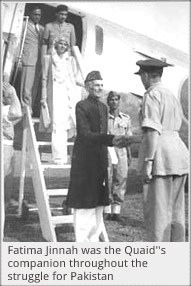
Miss Fatima Jinnah initially lived with her brother for about eight years till 1918, when he got married to Rutanbai. Upon Rutanbai’s death in February 1929, Miss Jinnah wound up her clinic, moved into Jinnah’s bungalow, and took charge of his house; thus beginning the life-long companionship that lasted till Jinnah’s death on September 11, 1948.
 In
all, Miss Jinnah lived with her brother for about 28 years, including
the last 19 tiring years of his life. The Quaid would discuss various
problems with her, mostly at the breakfast and dinner table. Paying
tribute to her sister, the Quaid once said, “My sister was like a bright
ray of light and hope whenever I came back home and met her. Anxieties
would have been much greater and my health much worse, but for the
restraint imposed by her”.
In
all, Miss Jinnah lived with her brother for about 28 years, including
the last 19 tiring years of his life. The Quaid would discuss various
problems with her, mostly at the breakfast and dinner table. Paying
tribute to her sister, the Quaid once said, “My sister was like a bright
ray of light and hope whenever I came back home and met her. Anxieties
would have been much greater and my health much worse, but for the
restraint imposed by her”.Miss Jinnah not only lived with her brother but also accompanied him on his numerous tours. In 1932, she joined him in London when he remained there after the Second Round Table Conference.
When the All India Muslim League was being organized, Miss Fatima Jinnah was taken on as a member of the Working Committee of the Bombay Provincial Muslim League, and worked in that capacity until 1947.
In March 1940, she attended the Lahore session of the Muslim League. Fatima was convinced that the Hindus intended to subjugate and dominate the Muslims completely. It was primarily due to her initiative that the All India Muslim Women Students Federation was organized in February 1941 at Delhi.
During the transfer of power in 1947, she was an inspiration to Muslim women. She formed the Women’s Relief Committee, which later formed the nucleus for the All Pakistan Women’s Association. She also played a significant role in the settlement of refugees in the new state of Pakistan.
 Despite
her old age, she continued to help social and educational associations.
During the Quaid’s illness, she remained passionately attached to him.
After his death, she often issued important statements on important
occasions, as a reminder to the nation of the ideals on which Pakistan
had been established.
Despite
her old age, she continued to help social and educational associations.
During the Quaid’s illness, she remained passionately attached to him.
After his death, she often issued important statements on important
occasions, as a reminder to the nation of the ideals on which Pakistan
had been established.In 1965, Miss Fatima Jinnah ran for President as a candidate of the Combined Opposition Party. Even a conservative party like the Jamaat-i-Islami accepted her as a woman presidential candidate. Miss Jinnah’s greatest advantage was that she was sister of the Founder of Pakistan and had been detached from the political conflicts that had plagued Pakistan after the Founder’s death. The sight of this dynamic lady moving in the streets of big cities, and even in the rural areas of a Muslim country, was both moving and unique. She proclaimed her opponent presidential candidate, Ayub Khan, a dictator. Miss Jinnah’s line of attack was that by coming to terms with India on the Indus Water dispute, Ayub had surrendered control of the rivers over to India. Her campaign generated such tremendous public enthusiasm that most of the press agreed that if the contest were by direct election, she would have won against Ayub.
 It
seems that the thought of doing a biography of her illustrious brother
came to Miss Jinnah about the time when Hector Bolitho’s “Jinnah Creator
of Pakistan” was first published in 1954. It was felt that Bolitho had
failed to bring out the political aspects of Jinnah’s life in his book.
Miss Jinnah started looking for a Pakistani author to do a biography of
the Quaid. G. Allana was her choice. G. Allana assisted Miss Jinnah on
the assignment but they parted company due to reasons undisclosed. Later
both carried on their independent works on Jinnah. Her book “My
Brother” was published by the Quaid-i-Azam Academy in 1987.
It
seems that the thought of doing a biography of her illustrious brother
came to Miss Jinnah about the time when Hector Bolitho’s “Jinnah Creator
of Pakistan” was first published in 1954. It was felt that Bolitho had
failed to bring out the political aspects of Jinnah’s life in his book.
Miss Jinnah started looking for a Pakistani author to do a biography of
the Quaid. G. Allana was her choice. G. Allana assisted Miss Jinnah on
the assignment but they parted company due to reasons undisclosed. Later
both carried on their independent works on Jinnah. Her book “My
Brother” was published by the Quaid-i-Azam Academy in 1987.The people of Pakistan hold Miss Fatima in high esteem. Due to her selfless work for Pakistan, the nation conferred upon her the title of Madar-i-Millat, or “Mother of the Nation”. She died in Karachi on July 8, 1967. Some historians indicate that the date of her death was actually July 2, 1967.
Following are excerpts from some of her statements.
 Madar-i-Millat’s
Message to the Nation on Eid-ul-Azha, 1967: “The immediate task before
you is to face the problem and bring the country back on the right path
with the bugles of Quaid-i-Azam’s message. March forward under the
banner of star and the crescent with unity in your ranks, faith in your
mission and discipline. Fulfill your mission and a great sublime future
awaits your enthusiasm and action. Remember: ‘cowards die many times
before death; the valiant never taste death but once.’ This is the only
course of action which suits any self-respecting people and certainly
the Muslim Nation.”
Madar-i-Millat’s
Message to the Nation on Eid-ul-Azha, 1967: “The immediate task before
you is to face the problem and bring the country back on the right path
with the bugles of Quaid-i-Azam’s message. March forward under the
banner of star and the crescent with unity in your ranks, faith in your
mission and discipline. Fulfill your mission and a great sublime future
awaits your enthusiasm and action. Remember: ‘cowards die many times
before death; the valiant never taste death but once.’ This is the only
course of action which suits any self-respecting people and certainly
the Muslim Nation.”Madar-i-Millat’s Message to the Nation on Eid-ul-Azha, 1965: “Let us sink all our differences and stand united together under the same banner under which we truly achieved Pakistan and let us demonstrate once again that we can, united, face all dangers in the cause of glory of Pakistan, the glory that the Quaid-i-Azam envisaged for Pakistan.”
Madar-i-Millat’s Message to the Nation on Quaid-i-Azam’s Birthday, 25 December, 1963: “The movement of Pakistan which the Quaid-i-Azam launched was ethical in inspiration and ideological in content. The story of this movement is a story of the ideals of equality, fraternity and social and economic justice struggling against the forces of domination, exploitation, intolerance and tyranny”.
